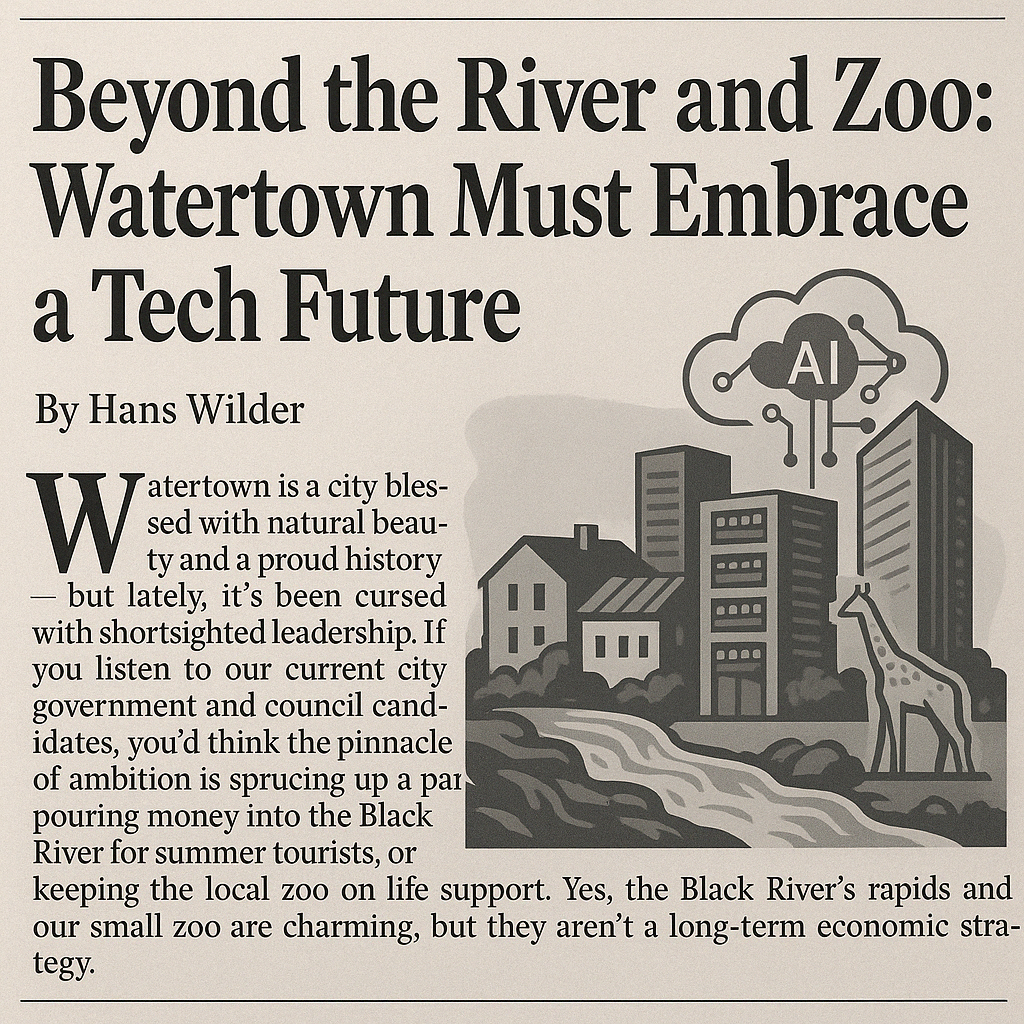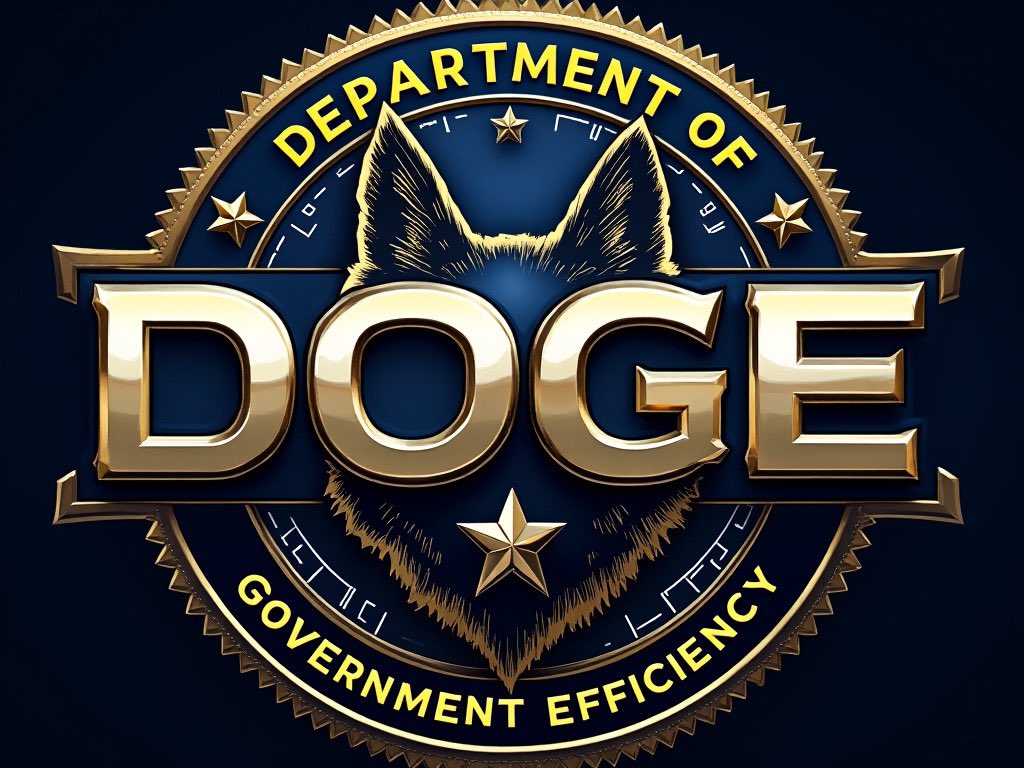By Hans Wilder
Watertown is a city blessed with natural beauty and a proud history – but lately, it’s been cursed with shortsighted leadership. If you listen to our current city government and council candidates, you’d think the pinnacle of ambition in 2025 is sprucing up a park, pouring money into the Black River for summer tourists, or keeping the local zoo on life support. Yes, the Black River’s rapids and our small zoo are charming, but they aren’t a long-term economic strategy. Simply managing the status quo or clinging to yesterday’s attractions is not enough. We need leaders who understand that maintaining a city is very different from transforming a city for the future. Watertown desperately needs a visionary, long-term plan – one that positions us as a future-forward powerhouse, not a nostalgic riverside stopover.
Short-Sighted Leadership Is Holding Watertown Back
In recent years, City Hall’s priorities have been disappointingly narrow. Millions of taxpayer dollars have been sunk into one-off projects with dubious long-term payoff – for example, the previous council majority spent almost $4 million on a third city swimming pool and another $3.4 million to buy a golf course in Thompson Park. These might be nice amenities, but they won’t put Watertown on the map or create sustainable growth. At the same time, truly forward-looking opportunities are met with a shrug or a committee. A prime example: the city’s hydroelectric plant contract with National Grid expires in 2030, threatening to wipe out millions in annual revenue. The local response so far? Talk of appointing a “hydro committee” to figure out options. That is reactive planning at best, not the proactive vision we need.
Meanwhile, our leaders celebrate small-ball successes and band-aid fixes. When the city zoo couldn’t afford to reopen this spring, the council narrowly approved an emergency $100,000 infusion just to keep it running. (This was after an earlier $60,000 bailout to get it through the winter, during which the zoo laid off two-thirds of its staff.) Even with that help, the zoo draws only about 30,000 visitors a year – a modest number for such heavy local subsidy. It’s clear that pouring money into struggling attractions and hoping for a tourism boom is not a blueprint for transformative growth. Yet, listen to many of our city officials and candidates and you’ll hear plenty about fixing potholes, keeping taxes low, and avoiding drama at council meetings – essentially, city management. What’s missing is any bold vision of what Watertown could be 10, 20, or 50 years from now. We deserve leadership that moves beyond merely reacting to problems and instead actively builds our future.
Our Hidden Advantages – and a Future Beyond Tourism
Here’s the reality: Watertown has latent strengths and untapped potential that could fuel a high-tech, innovative economy – if only we had the imagination to leverage them. We have something many tech hubs crave: abundant, renewable energy. The Black River, aside from offering rafting rides, also powers a hydroelectric plant. Instead of just selling that power to the grid (and fretting over the contract renewal), we could use it to entice data centers or other energy-intensive tech industries to set up shop here. In fact, there’s a growing trend of data centers migrating to cooler climates specifically to take advantage of reduced cooling costs and renewable power resources. That sounds like a description of Upstate New York – cool weather and plenty of clean hydroelectricity. Why not make Watertown a prime location for the next big server farm or cloud computing facility?
We also have cheap land and a strategic location. Watertown is located within reach of major markets in the Northeast and sits just south of the Canadian border. In an era of remote work and distributed tech operations, a company can put a data center or R&D facility here and serve the entire U.S. and Canada with ease. Our cooler climate isn’t a hindrance – it’s an asset for housing racks of servers that need constant cooling. We’re not prone to wildfires or hurricanes that threaten other regions’ infrastructure. And let’s not forget the human capital: we host a major Army installation at Fort Drum, which brings in skilled personnel and robust telecommunications infrastructure. We have local colleges and universities in our broader region. In short, Watertown has the ingredients to become more than a tourist pit stop – it could be an attractive home for data and innovation-driven industries, from AI server farms and cloud computing centers to “smart” manufacturing and logistics hubs.
The national and global trends back this up. Tech companies are in an arms race to build new infrastructure for the digital age. They’re investing “hundreds of billions of dollars” in data centers across the country – massive projects that are often hailed as economic game-changers. Even if these data centers don’t employ thousands of people on-site, they inject huge capital into local economies and signal that a community is part of the future. A recent industry analysis found that a typical data center project adds about $243 million to the local economy during construction, creates around 1,700 construction jobs, then sustains about 157 high-paying tech jobs long-term, all while generating over $1 million in new tax revenue each year. In a city of our size, 150+ new high-tech jobs and a million in extra revenue is a big deal. More importantly, landing such a project plants a flag that Watertown is a tech-friendly city – attracting satellite businesses, support services, and perhaps startup companies over time. That’s a far bigger impact than a few dozen seasonal tourism jobs or another retail chain store opening.
Other communities have already woken up to this potential. Look at what’s happening elsewhere in Upstate New York: the corridor from Buffalo through Rochester to Syracuse was just designated a federal Regional Tech Hub to bolster the semiconductor industry, coming with $40 million in funding to spur growth. Syracuse is poised to host one of the largest microchip fabrication facilities in the nation, part of the “semiconductor superhighway” in our state. While our neighbors capitalize on high-tech investment and nationwide attention, Watertown has been largely absent from the conversation – stuck polishing its old gems. We cannot afford to miss the boat. If we don’t actively align with the tech wave sweeping the country, we risk becoming a quaint afterthought while other cities in New York surge ahead.
And it’s not just big cities seizing the moment. Even rural areas are dreaming big. In Mississippi, one county spent years marketing itself to tech firms – and recently landed a commitment for a 300-acre data center campus with a private investment of about $10 billion. It’s the largest economic announcement in that state’s history, and it happened not in Jackson or a major metro, but on a stretch of once-forgotten land that leadership decided to pitch as the perfect tech site. How did they do it? By being proactive and thinking big: offering incentives (a decade of tax breaks), preparing shovel-ready land, and persistently courting the data center industry until someone said “yes.” If rural Mississippi can do it, why not Watertown? We have just as much potential – arguably more, given our location and resources. What we need is the will and vision to try.
Catching the Tech Wave: What Watertown’s Leaders Should Do
It’s time for Watertown’s mayor and city council to move beyond managing decline or tinkering with small projects. We need leadership that articulates a bold vision and goes out into the world to make it happen. That means our officials must be as comfortable talking about cloud computing and AI infrastructure as they are talking about parks and paving. They should be actively marketing Watertown as a city open for innovation. This isn’t a fantasy – it’s a necessity if we want to create jobs and prosperity for the next generation. So what would a forward-thinking Watertown game plan look like? Here are a few steps our leaders should be pursuing right now to align Watertown with the national tech wave:
- Aggressively market Watertown on the tech stage: The mayor and economic developers should be attending major tech conventions and trade shows – from CES in Las Vegas to SXSW in Austin – to pitch Watertown to the tech industry. (One big-city mayor recently said “tech has to be part of the conversation” and showed up in person at SXSW because it’s “one of the most influential tech conferences”. We need that same hustle here.) By having a presence at these events, our leaders can network with investors, learn what growing industries need, and broadcast Watertown’s advantages to a national audience. No one will consider investing here if they’ve never heard of us or our value proposition. Let’s change that by showcasing Watertown wherever innovators gather.
- Forge strategic partnerships and incentives: City Hall should be courting tech companies, data center operators, and research institutions with concrete proposals. That could mean partnering with a major cloud provider to build a regional data center campus on available land (sweetened by local tax incentives and cheap renewable power), or working with state and federal officials to designate parts of Watertown as an innovation zone. It might mean teaming up with universities (from Clarkson to Syracuse University) to establish a satellite tech incubator or research facility in Watertown. We should be knocking on every door – from Fortune 500 tech firms to up-and-coming startups – to tell them, “We’re open for business and we’ll support you if you choose Watertown.”
- Invest in digital infrastructure and skills: If we want to attract high-tech industry, we must demonstrate that we’re ready for it. That means ultra-fast internet connectivity citywide, robust 5G networks, and even exploring municipal broadband for cutting-edge reliability. It also means skilling up our workforce for tech jobs: forging programs with local schools, colleges, and Fort Drum to train residents in information technology, data center operations, cybersecurity, and other in-demand skills. A small city can absolutely produce talented tech workers – but it takes intentional investment in education and training. Let’s create a pipeline of local talent that companies can hire when they come here.
- Adopt “smart city” innovations at home: City leadership should lead by example and make Watertown itself a model of innovation. Why not pilot smart industry initiatives right here? We could implement smart traffic lights to improve flow, use AI for more efficient city services, or outfit parts of downtown with sensors to improve public safety and energy use. Showing that Watertown embraces technology in its own operations sends a message that we’re not stuck in the past. It creates a tech-friendly ecosystem that will make private innovators more likely to consider us. Plus, these improvements can save money and improve quality of life for residents – a win-win as we modernize our city management.
- Plan for tomorrow, not just today: Above all, the mayor and council must start articulating a clear, long-term vision for Watertown’s economy. This should be a written, public plan looking 10-20 years out, identifying target industries (like AI, cloud computing, renewable energy tech, advanced manufacturing) and laying out steps to attract them. We need to hear our leaders talk frequently about where Watertown is heading, not just where it has been. Every major decision – from budgeting to zoning to infrastructure – should be guided by the question: “Does this move us closer to the future we want 20 years from now?” If it doesn’t, why are we doing it? This kind of future-oriented mindset has been missing, and it’s high time it becomes the norm. As one of our own council members rightly put it, “You have to have vision… think about five years, 10 years, 50 years from now”. Exactly. Now let’s actually apply that principle beyond just building pools or fixing short-term problems.
Transformative Growth or Status Quo: The Choice is Ours
Watertown stands at a crossroads between being a caretaker city or a city of bold action. The rest of the world isn’t waiting for us: the digital revolution is charging ahead, and communities that embrace it are reaping the rewards. We cannot settle for leaders whose idea of planning is merely managing decline or playing it safe with minor tweaks. We need leaders who dream big and act boldly. Leaders who see our cool climate and surplus power not as afterthoughts, but as keys to becoming a data and innovation hub. Leaders who understand that promoting a city at a national level is part of the job description in 2025, not an extracurricular. In short, Watertown needs leadership that grasps transformative growth, not just day-to-day city administration.
Imagine a Watertown that is known nationally as a “small city with big tech energy” – where companies come to build the next cloud computing center, where startups test smart city ideas, where our young people can find cutting-edge jobs without leaving their hometown. This vision is not far-fetched; it’s entirely achievable if we commit to it. But it won’t happen by accident. It requires intentional vision from City Hall and the courage to break from old patterns. It means shifting focus from just keeping the lights on to actively brightening those lights into a beacon that attracts new opportunities.
The Black River and the zoo will always be parts of Watertown’s identity, and we can certainly continue to enjoy and promote them. But our future cannot rest on rafting trips and nostalgia alone. We must build on our strengths – renewable power, location, community – to create something new and dynamic. The next mayor and city council must lead the way by crafting and communicating a forward-thinking plan that all of us can get excited about. It’s time to put Watertown on the innovation map. With a clear vision and bold action, our city can transform from a place that talks about potential into a place that fulfills it. The choice is ours to make: cling to the past or forge a new future. I have no doubt which choice will make Watertown thrive – and I urge our leaders, present and future, to seize that future now.
Watertown deserves nothing less than a transformative leap forward. It’s time to catch the tech wave – or risk being left behind. Let’s dare to imagine Watertown not as a city that meekly manages what it has, but as a city that leads and innovates for the next generation. Our river has powered industries before; let’s use it – and our collective vision – to power a bold new era for Watertown. The world is moving fast, and we must move with it. All that’s needed is the leadership with courage to say: “Yes – Watertown’s future can be bigger than its past.”
Let’s get to work on that future, today.



